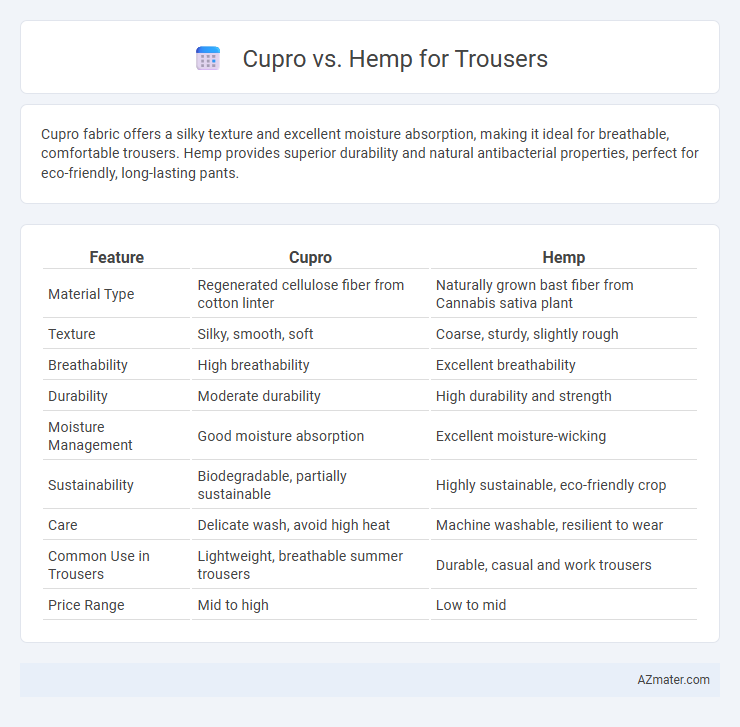Cupro fabric offers a silky texture and excellent moisture absorption, making it ideal for breathable, comfortable trousers. Hemp provides superior durability and natural antibacterial properties, perfect for eco-friendly, long-lasting pants.
Table of Comparison
| Feature | Cupro | Hemp |
|---|---|---|
| Material Type | Regenerated cellulose fiber from cotton linter | Naturally grown bast fiber from Cannabis sativa plant |
| Texture | Silky, smooth, soft | Coarse, sturdy, slightly rough |
| Breathability | High breathability | Excellent breathability |
| Durability | Moderate durability | High durability and strength |
| Moisture Management | Good moisture absorption | Excellent moisture-wicking |
| Sustainability | Biodegradable, partially sustainable | Highly sustainable, eco-friendly crop |
| Care | Delicate wash, avoid high heat | Machine washable, resilient to wear |
| Common Use in Trousers | Lightweight, breathable summer trousers | Durable, casual and work trousers |
| Price Range | Mid to high | Low to mid |
Introduction to Cupro and Hemp Fabrics
Cupro is a regenerated cellulose fiber derived from cotton linter, offering a silky texture and breathability ideal for trousers. Hemp fabric, made from the fibers of the Cannabis sativa plant, provides exceptional durability and natural moisture-wicking properties. Both materials serve as sustainable alternatives in fashion, with Cupro excelling in softness and drape, while Hemp stands out for strength and eco-friendliness.
Environmental Impact: Cupro vs Hemp
Hemp trousers have a significantly lower environmental impact compared to cupro, as hemp cultivation requires minimal water, no pesticides, and replenishes soil nutrients, making it highly sustainable. Cupro, a regenerated cellulose fiber derived from cotton linter waste, involves chemical processing that can pose environmental risks if not managed properly. Choosing hemp over cupro reduces water consumption and chemical pollution, promoting a more eco-friendly option for sustainable fashion.
Comfort and Breathability Comparison
Cupro trousers offer exceptional softness and moisture-wicking properties, making them highly comfortable for all-day wear. Hemp fabric is known for its superior breathability and natural antimicrobial qualities, which enhance airflow and keep the skin fresh in warm conditions. While Cupro excels in smooth texture and drape, hemp provides durable ventilation, making both fabrics ideal choices depending on the climate and wearer preferences.
Durability and Longevity of Trousers
Cupro trousers exhibit excellent durability due to their strong regenerated cellulose fibers, maintaining shape and resisting fading over time, making them ideal for long-term wear. Hemp trousers are highly robust, offering superior tensile strength and natural resistance to wear and tear, which enhances their longevity even under frequent use. Both fabrics provide sustainable options, but hemp's natural durability generally surpasses Cupro in terms of sustained lifespan and rugged use.
Aesthetic Appeal and Texture Differences
Cupro trousers exhibit a silky, smooth texture with a subtle sheen that enhances their luxurious aesthetic appeal, making them ideal for elegant and polished looks. Hemp fabric offers a coarse, matte finish with visible fibers, providing a natural, earthy appearance favored in casual or eco-conscious fashion. The key difference lies in Cupro's refined drape and softness compared to Hemp's structured, rugged feel, influencing the overall garment silhouettes.
Moisture-Wicking and Temperature Regulation
Cupro fabric offers excellent moisture-wicking properties due to its smooth, breathable fibers that effectively draw sweat away from the skin, keeping trousers dry and comfortable. Hemp, known for its natural temperature regulation, provides superior breathability and thermal insulation, making it ideal for both warm and cool climates. Combining these materials in trousers enhances moisture management and maintains optimal body temperature throughout varied environmental conditions.
Ease of Care and Maintenance
Cupro trousers are prized for their silk-like texture and smooth finish, offering easy care with wrinkle resistance and machine washability at low temperatures, which minimizes maintenance efforts. Hemp trousers, while highly durable and naturally resistant to pests and mold, usually require more careful laundering to prevent shrinkage and maintain fabric integrity, often necessitating gentle washing and air drying. Choosing between cupro and hemp for trousers involves balancing cupro's low-maintenance softness against hemp's robust durability and eco-friendly qualities.
Sustainability and Ethical Considerations
Cupro, a regenerated cellulose fiber made from cotton linter waste, offers a sustainable alternative by utilizing by-products of the cotton industry, reducing textile waste and promoting a circular economy. Hemp, a fast-growing, low-water crop requiring minimal pesticides, excels in environmental benefits through carbon sequestration and soil regeneration, making it one of the most eco-friendly fibers for trousers. Ethical considerations favor hemp for its organic cultivation practices and biodegradability, while Cupro's closed-loop production process minimizes chemical waste, ensuring both fibers align with sustainable fashion goals.
Cost Analysis: Cupro vs Hemp Trousers
Cupro trousers typically cost more than hemp due to the complex production process of regenerated cellulose fibers, which involves chemical treatments and higher manufacturing expenses. Hemp trousers offer a more cost-effective option, benefiting from sustainable cultivation and lower processing costs, making them ideal for budget-conscious consumers. Considering durability, hemp trousers may provide better long-term value, while cupro offers a softer texture often associated with premium pricing.
Best Use Cases: Choosing the Right Fabric for Trousers
Cupro offers a silky, breathable texture ideal for formal and office trousers, ensuring comfort and elegance throughout the day. Hemp provides superior durability and moisture-wicking properties, making it perfect for casual, outdoor, or summer trousers that require breathability and ruggedness. Choosing between Cupro and Hemp depends on the intended use: Cupro suits refined, professional settings, while Hemp excels in sustainable, hard-wearing apparel.

Infographic: Cupro vs Hemp for Trousers
 azmater.com
azmater.com